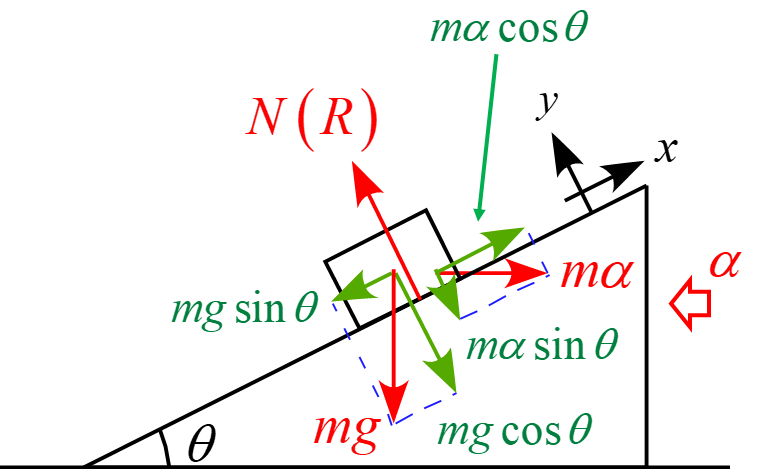問題
水平面となす角$\theta$の滑らかな斜面に質量$m$の物体を置いた。斜面を左向きに水平加速度$\alpha$で動かしたところ、物体は斜面を上り始めた。以下の問いに答えよ。
(1) 物体の運動方程式を記述せよ。
(2) 斜面上を長さ$L$移動するのにかかる時間$t_1$を求めよ。

解答
(1)
動く斜面に固定された座標系において、物体に作用する力は場の力「重力$mg$」と接触力「斜面からの抗力$R$」と慣性力「$m \alpha$」となり、座標軸$x,y$に沿って成分を分解すると図のようになる。(注: 斜面は滑らかで摩擦力が作用しないため、抗力$R$は斜面に垂直な方向にのみ作用し、傾くことはない。)

従って、運動方程式は
\begin{eqnarray*}
m a_x &=& -mg \sin \theta + m \alpha \cos \theta\\
\\
m a_y &=& N - mg \cos \theta - m \alpha \sin \theta\\
\end{eqnarray*}
となり、物体は斜面上での運動なので$a_y=0$(束縛条件)より
\begin{eqnarray*}
m a_x &=& -mg \sin \theta + m \alpha \cos \theta\\
\\
0 &=& N - mg \cos \theta - m \alpha \sin \theta\\
\end{eqnarray*}
となる。
(2)
運動方程式より加速度$a_x$は
\begin{eqnarray*}
a_x &=& -g \sin \theta + \alpha \cos \theta\\
\end{eqnarray*}
となるので、速度$v_x$は
\begin{eqnarray*}
a_x = \frac{\diff v_x}{\diff t} &=& -g \sin \theta + \alpha \cos \theta\\
\\
\int \frac{\diff v_x}{\diff t}\ \diff t &=& \int ( -g \sin \theta + \alpha \cos \theta)\ \diff t\\
\\
\int \diff v_x &=& \int ( -g \sin \theta + \alpha \cos \theta)\ \diff t\\
\\
v_x &=& ( -g \sin \theta + \alpha \cos \theta)\ t +C_1 \qquad (C_1:\mbox{積分定数})\\
\end{eqnarray*}
となる。スタート時は置かれた状態なので$v_x(0)=0$より
\begin{eqnarray*}
v_x (0) = ( -g \sin \theta + \alpha \cos \theta)\cdot 0 +C_1 &=&0 \\
C_1 &=& 0
\end{eqnarray*}
となるので
\begin{eqnarray*}
v_x (t) = ( -g \sin \theta + \alpha \cos \theta)\ t
\end{eqnarray*}
となる。さらに$t$で積分すると位置$x$は
\begin{eqnarray*}
v_x (t) = \frac{\diff x}{\diff t} &=& ( -g \sin \theta + \alpha \cos \theta)\ t \\
\\
\int \frac{\diff x}{\diff t}\ \diff t &=& \int ( -g \sin \theta + \alpha \cos \theta)\ t \diff t \\
\\
\int \diff x &=& \int ( -g \sin \theta + \alpha \cos \theta)\ t \diff t \\
\\
x &=& \frac{1}{2}( -g \sin \theta + \alpha \cos \theta)\ t^2 + C_2 \qquad (C_2:\mbox{積分定数})\\
\end{eqnarray*}
となる。$t=0$を原点として扱うと
\begin{eqnarray*}
x (0) = \frac{1}{2}( -g \sin \theta + \alpha \cos \theta)\ \cdot 0^2 + C_2 &=& 0 \\
\\
C_2 &=& 0
\end{eqnarray*}
となるので
\begin{eqnarray*}
x (t) = \frac{1}{2}( -g \sin \theta + \alpha \cos \theta)\ t^2 \\
\end{eqnarray*}
となる。
ここで、時刻$t_1$のとき、距離$L$だけ進むので
\begin{eqnarray*}
x (t_1) = \frac{1}{2}( -g \sin \theta + \alpha \cos \theta)\ t_1^2 &=& L \\
\\
t_1^2 &=& \frac{2L}{-g \sin \theta + \alpha \cos \theta} \\
\\
t_1 &=&\sqrt{\frac{2L}{\alpha \cos \theta -g \sin \theta}} \\
\end{eqnarray*}
となる。
注) この運動は斜面を上るので$\alpha \cos \theta -g \sin \theta >0 $である。